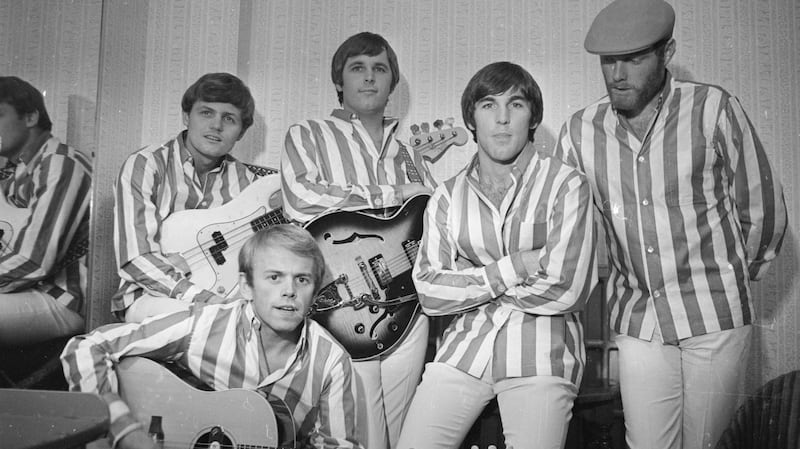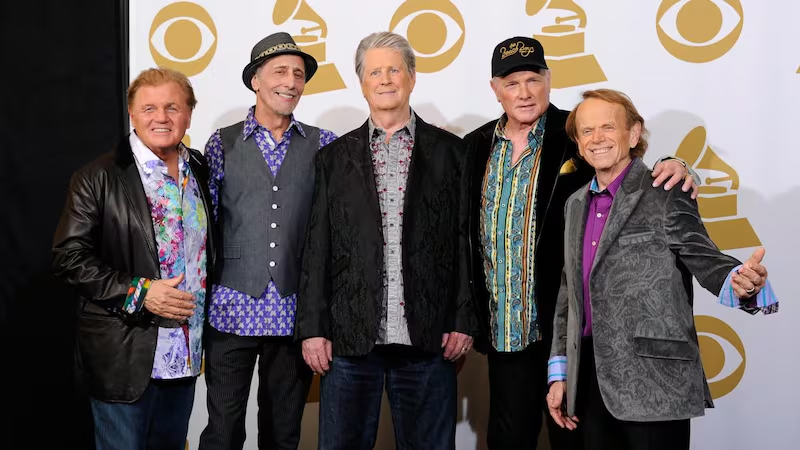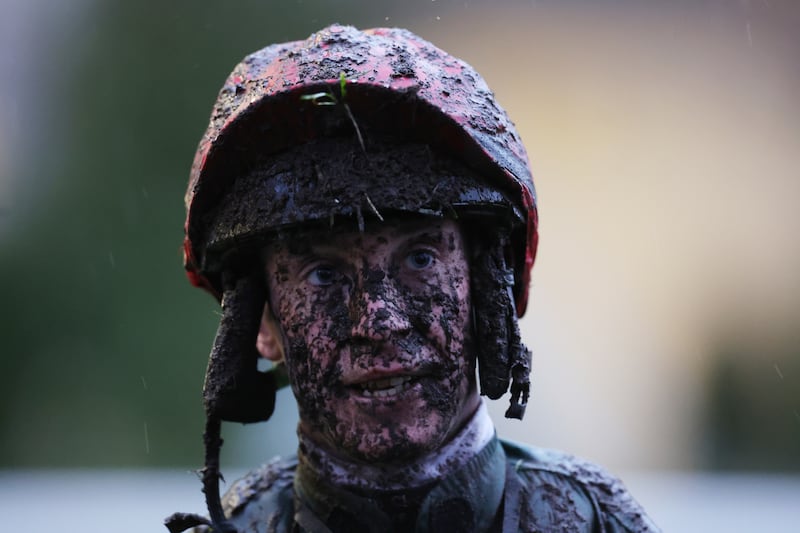In the 1960s, the Beach Boys staked their claim as the US’s most popular band, as their dazzling, harmony-drenched songs about surfing, cars and California Girls epitomised the American dream. So, at the end of the decade, when leader and principal songwriter Brian Wilson – who had recently spent several months in a psychiatric hospital – suggested that the band were on the verge of bankruptcy, everyone thought it was a joke.
“We arrived in London for a tour on the day that hit the headlines,” co-founder Al Jardine says over the phone from California. “The IRS [US tax collection agency] had closed our studio and our offices in Hollywood. The hotels wouldn’t accept our corporate credit cards. In the end, I had to use my personal American Express card to pay for our rooms.”
By 1969, the Beach Boys were still huge in Europe but without a label after a costly royalties dispute with Capitol. Their previous two albums had tanked in the US, too: 1968’s Friends limped to number 126. More darkly, they had been tainted by an association with Charles Manson, who befriended drummer Dennis Wilson in the months before the Manson Family’s 1969 Tate-LaBianca murders.
By Sunflower and Surf’s Up... they’re men in their late 20s who’ve been through a lot: family stuff, the brush with bankruptcy and Charles Manson
“I met him once and I didn’t want to meet him any more,” Jardine, now 78, shudders. “He was very hypnotic. He came over to use our studio. He played me a song he’d written and I started getting dizzy. I couldn’t wait to get out of there, but for some reason he cast a spell on other people.” There’s a moment’s silence as he reflects on how close they came. “He crashed one of Dennis’s cars. To be honest, I don’t know how Dennis got out alive.”
Incredibly, this turbulence produced some of the most beautiful music of the band’s career. Sunflower (1970) and Surf’s Up (1971) – which are reissued this week in Feel Flows, a 135-track treasure trove including numerous alternate takes, curiosities and long-lost gems – restored their reputation critically, then commercially.
“By Sunflower and Surf’s Up, the other characters in the band are starting to emerge,” says Supergrass frontman Gaz Coombes, one of the many musicians influenced by this stunning pair of albums. “They’re no longer teenagers – they’re men in their late 20s who’ve been through a lot: family stuff, the brush with bankruptcy and Charles Manson. Somehow out of this comes music that sounds like a warm hug.”

“Music was our way of healing,” says Bruce Johnston (keyboards/vocals), a genial 79-year-old, who joined in 1965 and is speaking from Missouri. Jardine has similarly happy memories: “We were all friends. Brian was coming back.”
Wilson, who had a first nervous breakdown in 1964, had been crushed by the pressure for hit songs. “When I joined the band [over the next 11] months, I toured and made three albums,” Johnston observes. “Thats incredible, isn’t it? It was just: what’s next? We were too young to protest.”
Johnston attended the listening party for the Beatles’ Rubber Soul – along with various other members of the Beach Boys, the Mamas and the Papas and Doris Day – which inspired Pet Sounds. “Rubber Soul was obviously a leap forward,” he says, “so Brian started to think, ‘Maybe I should make an album of completely connected songs, that’s just scarily incredible’.”
It was the happiest time. I was 29. I had my Porsche, a great girlfriend, no responsibilities. I’d go surfing in the evening and record during the day
Capitol Records didn’t understand Wilson’s melancholy paeans to youthful innocence on Pet Sounds. “He makes this gorgeous album and they go ‘Have you got any hits?’” sighs Johnston of an album that contained God Only Knows and Wouldn’t It Be Nice, and is often named the greatest LP of all time. “So he pushed himself too hard on Smile.” In 1967, Wilson abandoned this projected follow-up, by which time his initially creative use of LSD was damaging his mind. “And people would try to steal Brian. They’d go, ‘You don’t need the Beach Boys, man. Take this pill.’ I just remember that when I started working with him he was dressed great – hip, cool, happening, y’know? Then he went backwards, all the way to wearing his pyjamas.”
As the Sunflower sessions began, Wilson stopped turning up to studios, so the band relocated to a 16-track facility in his living room in Bel Air, the idea being (as well as saving money) that the studio might be more tempting if it was two floors below his bedroom.
“The studio was our man-cave,” Johnston remembers, cheerily. “It was the happiest time. I was 29. I had my Porsche, a great girlfriend, no responsibilities. I’d go surfing in the evening and record during the day.”
Jardine describes the daily ritual: “Go to the house, raid the refrigerator, then get to work.” Because of Wilson’s fragility, Sunflower became their first group effort, with members showcasing their blossoming talents as lead singers or songwriters, such as Dennis with the extraordinary Forever.
“Brian was retreating from the commercial world and we began to make more personal music,” Jardine says. “We all supported each other, so you’d work on your own thing or someone else’s. We all listened to each other, which was a wonderful feeling. Every so often, Brian would hear something coming up through the floor and come hurtling down.” Usually in his bathrobe. In the Feel Flows box liner notes, engineer Stephen Desper recalls how Wilson’s creativity was so spontaneous that he had to “chase him around the studio with microphones” to capture what he was doing.
That sun-soaked California vibe just pours out of the music, but then there are these sudden chord changes, weird edits or left turns
Johnston twitters like a sparrow on Jardine’s At My Window. Wilson and singer/cousin Mike Love’s hazy All I Wanna Do virtually invents shoegaze, 20 years before its time. “We were a little ahead in that we were experimenting with technology,” Jardine recalls. “We borrowed these big synthesisers from Robert Moog and stuffed them into the control room. I remember playing Cool, Cool Water for [new label] Reprise on huge loudspeakers in the dark. This single note came out of the synthesiser and shook the room. Everyone was blown away.”
Although Reprise subsequently rejected an initial version, Sunflower is now generally viewed as one of their greatest albums. “There’s a real warmth to these records, compared to the thinner sounding ones they’d made earlier,” Coombes says. “That sun-soaked California vibe just pours out of the music, but then there are these sudden chord changes, weird edits or left turns. As a young sort-of songwriter who was getting into bands, finding out about the dynamics in the Beach Boys was fascinating, and a big influence.”
At the time, though, despite rave reviews, it reached a disastrous number 151 in the US, shifting fewer copies than 1968’s Friends. “We weren’t hip,” Johnston says. “The radio wouldn’t play us.” What he calls their “scrubbed clean image” of matching suits and surfboards didn’t square with the prevailing counterculture or newer, heavier artists such as Jimi Hendrix or the Doors, which wasn’t entirely fair. “Half the band’s behaviour was hardly squeaky clean. Don’t forget we had the Vietnam war going on, but people probably didn’t realise Carl was a conscientious objector [who refused the draft]. It felt like the music world was heading in the opposite direction.”
Touring the old hits abroad helped financially and the Boys got with the programme: their new manager Jack Rieley insisted those suits had to go. The subsequent Surf’s Up album isn’t the first “ecological album” (that’s probably Pete Seeger’s 1966 God Bless the Grass) but certainly seems prescient today.

“It was a different kind of pollution then,” Jardine muses. “Don’t Go Near the Water was about how phosphates in our soaps had got into the water. Now it’s lead in the pipes. If we’ve helped bring awareness to any of this stuff I’ll be very happy.” Love and Johnston remain involved with beach campaigners the Surfrider Foundation, the latter having become environmentally aware as a schoolboy, when domestic incinerator smog meant “we’d have to go inside during physical education because we were all coughing”.
Although Carl’s beatifically hazy Feel Flows could fit on Primal Scream’s Screamadelica, Surf’s Up captures the zeitgeist of its times. “We’d grown up with Disney,” says Johnston, “but suddenly there was all this horrible stuff.” Love’s Student Demonstration Time referenced the 1970 Kent State shootings while Johnston’s own sublime Disney Girls pined for more innocent times. “These young high-school girls showed us they could inhale pot,” says Johnston, still the archetypal clean-living Beach Boy. “I thought, that’s not where I was at your age.”
By now, Carl had taken the reins as his brother remained troubled. Brian wrote the eco anthem A Day in the Life of a Tree, then insisted that Rieley sing it. “That was highly creative,” Johnston says, chuckling. “He did sound like a gnarled old tree.” The stellar title track was rescued from Smile tapes that were “lying around” the house. “I said to Carl, ‘We need to finish this,’” Jardine recalls, “so Carl, Bruce and I took over the production. Carl finished some of the vocals and we worked from sunset to sunrise just on the final mix.”
Meanwhile, reports of its troubled composer’s behaviour ranged from having his own grave dug in his backyard to attempting to drive off a cliff. “I don’t remember anything like that,” says Jardine, but he does recall Brian’s cheery excitement as he announced new song ’Til I Die. “I was hoping for something a little more… optimistic,” he laughs. “You know, another hit! Instead it was all these morbid thoughts, but it turned into one of the most beautiful selections on the album. ‘I’m a cork on the ocean…’ Wow: that’s deep.”
They started out as kids, rehearsing in living rooms and garages. To this day, if you get them together in a room without anyone else, that’s what they go back to
Released – again – to rapturous reviews, with an amusing advert (“It’s now safe to listen to the Beach Boys”), Surf’s Up became their highest-charting album since 1967. Engineer Alan Boyd, who assembled the new box set with Mark Linett, remembers his mother taking him to see the Beach Boys touring the album at San Francisco Winterland when he was nine. “They did the new songs and the oldies like Surfin’ USA, and I Get Around,” he smiles over Zoom. “The balcony was shaking.” Linett says: “They had to find their audience again, but once they did, everyone realised that the old songs were still fantastic.”
The home studio was dismantled in 1972, Dennis drowned in 1983 and Carl died of cancer in 1998. Since then, Love successfully fought Jardine in court for the use of the band name; a 50th anniversary reunion tour ended sourly, while Jardine now tours with Brian. In 2020, the pair urged fans to boycott the Love-Johnston touring Beach Boys after they were booked to play a hunting group event which had Donald Trump Jr as a speaker. Johnston insists that Love never took the stage. When I ask Jardine what he thinks about Love’s tours he suddenly loses phone signal, finally offering, “Um, I don’t have a whole lot to say about that.”
Lately, though, communication for the box set seems to have rekindled some healing. Jardine, Johnston and Love appear on a new version of Add Some Music to Your Day (a Wilson/Love song on Sunflower) for charity and there have been hints at a 60th anniversary reunion. Johnston is more enthusiastic about his work with Skrillex than the idea of recording any new Beach Boys music, but says, “I would expect a televised event.”
Jardine is more optimistic. “We’re hoping to put together 10 or so concerts, worldwide, maybe something for charity,” he says, “while we still have our voices. It would be the appropriate time to come back together and do some great things.”
If this seems unlikely, Boyd explains: “They started out as kids, rehearsing in living rooms and garages. To this day, if you get them together in a room without anyone else, that’s what they go back to. They really are the ultimate garage band.”Feel Flows: The Sunflower and Surf’s Up Sessions 1969-71 box set is out now via Capitol/UMe



















